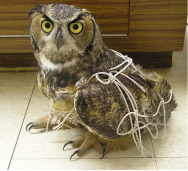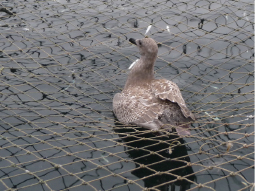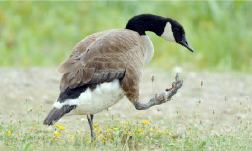Entanglement

Thousands of birds are injured or killed each year as the result of becoming tangled in a variety of man-made materials. If birds become entangled they are essentially trapped and cannot free themselves without assistance. They are prevented from flying, walking, feeding and avoiding predators. Prolonged entanglement can cause permanent physical damage to skin, feathers, muscles, nerves or bones.
What to do if you find an entangled bird:
Call a wildlife rehabilitation center such as Willowbrook Wildlife: 630 942-6200 for help and advice if you encounter a bird in an entanglement situation (particularly if it involves a bird that would be dangerous to safely handle (e.g. herons, bitterns, cormorants, owls, hawks). If you are unable to reach a rehabilitation center, call the CBCM hotline for help: 773 988-1867
Critical step: hold the bird while you cut/untangle the material that is restraining it. It may seem the most urgent thing to get the bird free from restraint but containing the bird is more important. If you cut/remove only enough material to free the bird — it may escape with hooks and string still attached to its body which will continue to harm it and in many cases eventually cause the bird's death.

Do not just cut a bird free!!! Capture — then cut!
If the entangling material is embedded in the bird's skin or wrapped very tightly, do not attempt to remove it yourself. Doing so may cause even greater damage to the bird. Cut away enough of the material to get the bird loose and transport it to a wildlife rehabilitation center where trained staff can safely remove the entangling material.
If a bird is small enough and reachable: wrap/cover its body in a towel, pillow case or net to contain it while you unwrap netting or cut string/line.
If the tangled bird is suspended out of reach: be ready to catch the bird if it falls after the restraining material is cut. Do not allow a bird to drop into an area where it may sustain further injuries, get away, not be able to be reached, or even drown if it falls into water still tangled!
Once you have contained the bird and cut away the entangled material — DO NOT LET THE BIRD GO! It is likely that the bird has sustained an injury from the string, netting, or hook, and needs to be taken to a wildlife rehabilitation center for evaluation. The bird should be examined and treated for any damage that the entanglement may have caused (lacerations, infections, nerve or tissue damage). Birds can be safely transported by placing them in a closed paper bag or covered cardboard box.
Entanglement Hazards include:

Fishing line and its associated hooks and tackle that have been improperly disposed of along beaches, lakes, and ponds is the leading cause of wildlife entanglement. Line and tackle left behind in branches and bushes become tangled on the legs, wings, and beaks of birds.
Use proper disposal containers, cut disposed fishing line into small, safe pieces that will not become a risk to wildlife, spend some time cleaning up fishing line debris at a local pond, lake or beach, and support the use of biodegradable fishing line. More common use of a fishing line that did not have a prolonged life-span in the environment could reduce entanglement risks.
Kite or balloon strings caught in overhead branches or bushes can fatally trap a bird. Chicago Bird Collision Monitors rescued a mallard suspended upside down, for more than seven hours, 50 feet above the ground by kite string that had become tangled on its leg! When a kite becomes snagged in a tree, always remove as much of the string as can be safely reached. Be careful to never release balloons into the environment where the balloons and the string become hazards to wildlife.
Plastic six-pack rings for cans or plastic bottles or any other plastic ring from a container should always be cut apart before they are disposed of so there are no openings that could get stuck on the head or limb of an animal.
Soccer goal netting can trap nocturnal wildlife such as owls or cottontails that do not see the netted barrier as they run or fly through an open field at night. Animals and birds will be seriously injured or die as they struggle to free themselves once they become caught. If your park or school has soccer fields, please make sure the goal netting can be removed when not in use.
Holiday decorations can also be dangerous to wildlife. Birds become caught on loosely hung strings of outdoor holiday lights. The popular sticky, stringy spider webbing decorations placed across bushes at Halloween ensnare birds that live or feed in the vegetation. Birds will panic and injure themselves trying to escape or be trapped until they die in the webbing. Please make sure your holiday decorations are safe for wildlife.
Landscape netting used for turf reinforcement, plantings, and erosion control can trap birds, small animals, and the predators that pursue them. This ground cover can be particularly hazardous when placed where aquatic birds and their young exit the water to reach land. Areas that are netted should be frequently checked and should use degradable netting products that break down faster than standard plastic ground covers.
Netted covers for trees intended to keep birds from reaching ripening fruit often snag the birds they are trying to exclude. If you use a cover for a fruit tree, it is important to frequently check for trapped birds.

